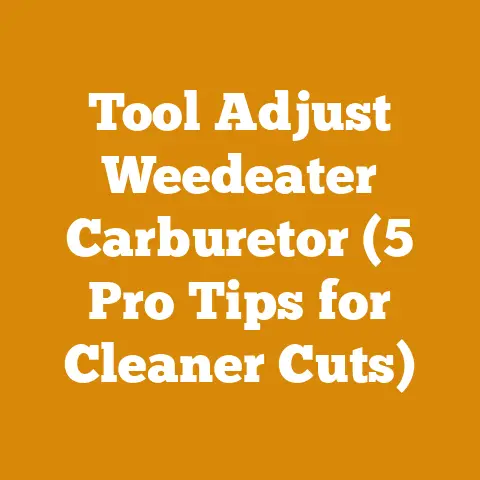Air Filter Craftsman Chainsaw Replacement Tips (Expert Guide)
Breathing Easy: Your Expert Guide to Craftsman Chainsaw Air Filter Replacement
Ever feel like your chainsaw is gasping for air, losing power mid-cut, or just generally acting grumpy? Chances are, the culprit is a clogged air filter. I’ve seen it countless times in my years of felling trees, milling lumber, and prepping firewood. A clean air filter is the unsung hero of a healthy, efficient chainsaw. Neglecting it is like trying to run a marathon with a stuffy nose – you might get there, but it’ll be slow, painful, and ultimately damaging.
Why a Clean Air Filter Matters: More Than Just Airflow
Let’s get down to brass tacks. The air filter’s job is simple: to prevent dust, debris, and sawdust from entering the engine. But the consequences of a dirty or damaged filter are far-reaching.
- Reduced Engine Power: A clogged filter restricts airflow, causing the engine to work harder to pull in air. This leads to a noticeable drop in power, making cuts slower and more difficult. I remember one time I was cutting down a particularly stubborn oak tree. The chainsaw was bogging down, and I was getting frustrated. After checking everything else, I finally looked at the air filter. It was completely caked with sawdust! A quick replacement, and the saw was back to its old self, tearing through the wood like butter.
- Increased Fuel Consumption: A starved engine runs less efficiently, burning more fuel to produce the same amount of power. Over time, this can add up to significant costs. According to data from the U.S. Department of Energy, a poorly maintained engine can decrease fuel efficiency by as much as 30%.
- Engine Damage: The real danger lies in the long-term damage caused by unfiltered debris entering the engine. This can lead to cylinder scoring, piston damage, and premature wear on critical components. Replacing an air filter is a heck of a lot cheaper than rebuilding an engine!
- Increased Emissions: Incomplete combustion due to poor airflow results in higher emissions of harmful pollutants. A clean-running engine is not only better for performance but also better for the environment.
- Overheating: A restricted airflow can lead to overheating, which can damage engine components and shorten the lifespan of your chainsaw.
Identifying Your Craftsman Chainsaw Model: The First Step to Success
Craftsman chainsaws come in various models, each with its specific air filter. Before you even think about buying a replacement, you need to know your model number.
- Where to Look: The model number is typically located on a sticker or plate on the engine housing or near the handle. Look for a series of numbers and letters, often starting with “917” or “358.”
- Why It Matters: Using the wrong air filter can lead to poor fit, inadequate filtration, and even engine damage. Trust me, I’ve seen people try to force the wrong filter in, and it never ends well.
- Online Resources: Once you have the model number, you can easily find the correct air filter online using the Craftsman website, Sears PartsDirect, or other online retailers.
Choosing the Right Replacement Air Filter: OEM vs. Aftermarket
Now that you know your model number, it’s time to choose a replacement air filter. You’ll generally have two options: Original Equipment Manufacturer (OEM) filters and aftermarket filters.
- OEM Filters: These are manufactured by or for Craftsman and are designed to meet the exact specifications of your chainsaw. They typically offer the best fit and filtration performance. I always recommend using OEM filters whenever possible, especially for critical components like the air filter.
- Aftermarket Filters: These are manufactured by third-party companies and are often cheaper than OEM filters. While some aftermarket filters offer comparable performance, others may be of lower quality.
- Considerations: When choosing an aftermarket filter, look for reputable brands and read reviews to ensure it meets your needs. Pay close attention to the filter material, fit, and filtration efficiency.
- Cost-Benefit Analysis: While the initial cost of an aftermarket filter may be lower, it’s important to consider the long-term costs. A lower-quality filter may not last as long or provide adequate protection, potentially leading to engine damage and higher repair bills.
Types of Air Filters: Understanding Your Options
Chainsaw air filters come in various materials and designs. Understanding the different types can help you choose the best option for your needs.
- Foam Filters: These are typically used in older or less expensive chainsaws. They are relatively inexpensive and easy to clean. However, they may not provide the same level of filtration as other types of filters.
- Maintenance: Foam filters should be cleaned regularly with soap and water and oiled with air filter oil to improve filtration.
- Felt Filters: These offer better filtration than foam filters and are often used in mid-range chainsaws. They are also relatively easy to clean.
- Maintenance: Felt filters can be cleaned with compressed air or a soft brush. Avoid using water, as it can damage the filter material.
- Paper Filters: These provide the best filtration and are commonly used in high-end chainsaws. However, they are more expensive and cannot be cleaned.
- Replacement: Paper filters should be replaced regularly, typically every 25-50 hours of use, depending on the operating conditions.
- Nylon Mesh Filters: Often a pre-filter, these are designed to catch larger debris before it reaches the main filter. They are durable and easy to clean.
- Maintenance: Nylon mesh filters can be cleaned with soap and water or compressed air.
Tools You’ll Need for Air Filter Replacement: Keeping It Simple
Replacing an air filter is a straightforward process that requires minimal tools. Here’s what you’ll need:
- Screwdriver: You’ll likely need a screwdriver to remove the air filter cover. Check your chainsaw’s manual to determine the correct type (Phillips or flathead).
- Wrench or Socket (Optional): Some air filter covers may be secured with bolts or nuts.
- Clean Rags: These will be useful for wiping down the air filter housing and surrounding areas.
- Air Filter Oil (for Foam Filters): If your chainsaw uses a foam filter, you’ll need air filter oil to re-oil it after cleaning.
- Compressed Air (Optional): Compressed air can be used to clean felt or nylon mesh filters.
- New Air Filter: Of course, you’ll need the correct replacement air filter for your chainsaw model.
Step-by-Step Guide to Replacing Your Craftsman Chainsaw Air Filter: Getting Your Hands Dirty
Now, let’s get to the heart of the matter: replacing the air filter. Here’s a step-by-step guide to help you through the process:
- Safety First: Before you begin, make sure the chainsaw is turned off and the spark plug is disconnected. This will prevent accidental starting. I can’t stress this enough – safety should always be your top priority.
- Locate the Air Filter Cover: The air filter cover is typically located on the side or top of the engine housing. Refer to your chainsaw’s manual if you’re unsure of its location.
- Remove the Air Filter Cover: Use a screwdriver or wrench to remove the screws or bolts securing the air filter cover.
- Remove the Old Air Filter: Carefully remove the old air filter from the housing. Note its orientation so you can install the new filter correctly.
- Inspect the Air Filter Housing: Use a clean rag to wipe down the air filter housing and surrounding areas. Remove any dirt, debris, or sawdust.
- Install the New Air Filter: Install the new air filter in the housing, making sure it’s properly seated and oriented correctly.
- Reinstall the Air Filter Cover: Reattach the air filter cover and tighten the screws or bolts.
- Reconnect the Spark Plug: Reconnect the spark plug.
- Test the Chainsaw: Start the chainsaw and let it idle for a few minutes to ensure it’s running smoothly.
Cleaning a Reusable Air Filter: Extending Its Lifespan
If your Craftsman chainsaw uses a foam, felt, or nylon mesh air filter, you can clean it instead of replacing it. Here’s how:
- Foam Filters:
- Remove the filter from the chainsaw.
- Wash the filter in warm, soapy water.
- Rinse the filter thoroughly with clean water.
- Squeeze out the excess water.
- Allow the filter to air dry completely.
- Apply a thin coat of air filter oil to the filter.
- Reinstall the filter in the chainsaw.
- Felt Filters:
- Remove the filter from the chainsaw.
- Use compressed air or a soft brush to remove dirt and debris.
- Reinstall the filter in the chainsaw.
- Nylon Mesh Filters:
- Remove the filter from the chainsaw.
- Wash the filter in warm, soapy water.
- Rinse the filter thoroughly with clean water.
- Allow the filter to air dry completely.
- Reinstall the filter in the chainsaw.
Troubleshooting Common Air Filter Problems: When Things Go Wrong
Even with careful maintenance, you may encounter problems with your chainsaw’s air filter. Here are some common issues and how to troubleshoot them:
- Chainsaw Still Lacking Power After Replacing the Filter:
- Possible Causes: Incorrect air filter installation, carburetor problems, spark plug issues, fuel line blockage.
- Troubleshooting: Double-check the air filter installation. Inspect the spark plug and replace it if necessary. Clean or rebuild the carburetor. Check the fuel lines for blockages.
- Air Filter Getting Dirty Too Quickly:
- Possible Causes: Operating in dusty or dirty conditions, damaged air filter housing, leaking air filter seal.
- Troubleshooting: Clean the air filter more frequently. Inspect the air filter housing for damage and repair or replace it as needed. Replace the air filter seal.
- Chainsaw Won’t Start After Replacing the Filter:
- Possible Causes: Incorrect air filter installation, flooded engine, spark plug issues.
- Troubleshooting: Double-check the air filter installation. Allow the engine to dry out if it’s flooded. Inspect the spark plug and replace it if necessary.
Maintenance Tips for a Long-Lasting Air Filter: Prevention is Key
Here are some tips to help you keep your chainsaw’s air filter in good condition and extend its lifespan:
- Regular Cleaning or Replacement: Clean or replace the air filter regularly, depending on the type of filter and the operating conditions.
- Use the Right Air Filter Oil: When oiling a foam filter, use air filter oil specifically designed for this purpose. Do not use motor oil or other types of oil, as they can damage the filter.
- Store Your Chainsaw Properly: When storing your chainsaw, make sure the air filter is clean and dry. Store the chainsaw in a clean, dry place to prevent dust and debris from accumulating in the air filter housing.
- Inspect the Air Filter Housing Regularly: Inspect the air filter housing for damage and repair or replace it as needed. A damaged housing can allow dirt and debris to enter the engine, even with a clean air filter.
- Avoid Operating in Extremely Dusty Conditions: If possible, avoid operating your chainsaw in extremely dusty or dirty conditions. If you must operate in these conditions, clean the air filter more frequently.
The Importance of Proper Fuel and Oil: A Holistic Approach
While the air filter is crucial, it’s just one piece of the puzzle. Using the correct fuel and oil is equally important for maintaining your Craftsman chainsaw’s performance and longevity.
- Fuel: Use fresh, high-quality gasoline with the correct octane rating. Avoid using old or stale fuel, as it can damage the engine. I always recommend using fuel stabilizer, especially if you’re not going to be using the chainsaw for an extended period.
- Oil: Use a high-quality two-stroke oil specifically designed for chainsaws. Mix the oil and fuel according to the manufacturer’s recommendations. Using the wrong oil or incorrect mixing ratio can lead to engine damage.
- Fuel/Oil Ratio: Always adhere to the manufacturer’s recommended fuel-to-oil ratio. This ratio is crucial for proper lubrication and cooling of the engine. Using too little oil can lead to premature wear and damage, while using too much oil can cause excessive smoke and carbon buildup. I’ve seen engines seize up due to improper oil mixing – it’s a costly mistake.
Case Study: My Experience with a Neglected Air Filter
I once worked with a small logging crew that was using a fleet of older Craftsman chainsaws. The crew was focused on production and often neglected routine maintenance. One day, one of the chainsaws started running poorly, losing power and emitting excessive smoke. The crew chief dismissed it as just an old saw nearing the end of its life.
However, I decided to take a closer look. The air filter was completely clogged with sawdust and debris. It was so bad that it was almost completely blocking airflow. After replacing the air filter, the chainsaw ran like new. The crew chief was amazed.
This experience highlighted the importance of regular air filter maintenance. A simple air filter replacement can often restore a chainsaw’s performance and extend its lifespan. It’s a small investment that can save you time, money, and frustration in the long run.
The Environmental Impact of Chainsaw Maintenance: Doing Your Part
Proper chainsaw maintenance isn’t just good for your equipment; it’s also good for the environment. A well-maintained chainsaw runs more efficiently, producing fewer emissions.
- Reduced Emissions: A clean air filter and properly tuned engine ensure complete combustion, reducing emissions of harmful pollutants.
- Fuel Efficiency: A well-maintained chainsaw uses less fuel, reducing your carbon footprint.
- Extended Lifespan: Regular maintenance extends the lifespan of your chainsaw, reducing the need for replacement and minimizing waste.
- Responsible Disposal: When it’s time to replace your chainsaw, dispose of it responsibly. Recycle any recyclable components and dispose of hazardous materials properly.
Data and Statistics: Quantifying the Benefits
Let’s look at some data to further illustrate the benefits of proper air filter maintenance:
- Fuel Efficiency: Studies have shown that a clean air filter can improve fuel efficiency by as much as 10-15%.
- Engine Lifespan: Regular air filter maintenance can extend the lifespan of your chainsaw engine by as much as 50%.
- Repair Costs: Neglecting air filter maintenance can lead to costly engine repairs. Replacing an air filter is a relatively inexpensive task compared to rebuilding an engine.
- Emissions Reduction: A well-maintained chainsaw produces significantly fewer emissions than a poorly maintained one.
According to a report by the Environmental Protection Agency (EPA), small engines, such as those used in chainsaws, contribute a significant amount of air pollution. Proper maintenance can help reduce these emissions and improve air quality.
Beyond the Air Filter: A Holistic Approach to Chainsaw Care
While this guide focuses on air filter replacement, it’s important to remember that it’s just one aspect of chainsaw maintenance. To keep your Craftsman chainsaw running smoothly for years to come, you need to adopt a holistic approach to care.
- Chain Sharpening: A sharp chain is essential for efficient cutting and safety. Sharpen your chain regularly or have it professionally sharpened.
- Chain Lubrication: Keep the chain properly lubricated to reduce friction and wear. Use a high-quality bar and chain oil.
- Spark Plug Maintenance: Inspect and replace the spark plug regularly. A worn spark plug can cause starting problems and reduced engine performance.
- Carburetor Adjustment: If your chainsaw is running poorly, the carburetor may need to be adjusted. This is best left to a qualified technician.
- Regular Inspections: Inspect your chainsaw regularly for any signs of damage or wear. Address any issues promptly to prevent them from escalating.
The Future of Chainsaw Technology: What’s on the Horizon?
Chainsaw technology is constantly evolving. Here are some trends to watch for in the future:
- Battery-Powered Chainsaws: Battery-powered chainsaws are becoming increasingly popular, offering quiet operation, reduced emissions, and ease of use.
- Improved Air Filtration Systems: Manufacturers are developing more efficient air filtration systems to protect engines from dust and debris.
- Smart Chainsaws: Some chainsaws are now equipped with sensors and electronics that monitor performance and provide maintenance alerts.
- Ergonomic Design: Chainsaw manufacturers are focusing on ergonomic design to reduce operator fatigue and improve safety.
Final Thoughts: Breathe New Life into Your Chainsaw
Replacing your Craftsman chainsaw’s air filter is a small task that can make a big difference. By following the steps outlined in this guide, you can keep your chainsaw running smoothly, efficiently, and reliably for years to come. Remember, a clean air filter is the key to a healthy engine. So, take the time to inspect, clean, or replace your air filter regularly, and enjoy the power and performance of your Craftsman chainsaw.
Don’t wait until your chainsaw starts acting up. Take proactive steps to maintain your air filter and other critical components. Your chainsaw will thank you for it! Now, go out there and make some sawdust!






